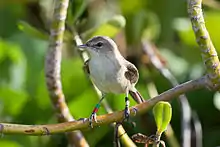Millerbird
The millerbird (Acrocephalus familiaris) is a species of Old World warbler in the family Acrocephalidae. It has two subspecies, A. f. kingi and A f. familiaris. The latter, the Laysan millerbird, became extinct sometime between 1916 and 1923. The former, the critically endangered Nihoa millerbird, remains the only race left, inhabiting the small island Nihoa in Hawaiʻi, though it has since been reintroduced to Laysan. It is the only Old World warbler to have colonised Hawaiʻi, although there is no fossil evidence that the species ever had a distribution beyond these two islands.
| Millerbird | |
|---|---|
 | |
| Scientific classification | |
| Kingdom: | Animalia |
| Phylum: | Chordata |
| Class: | Aves |
| Order: | Passeriformes |
| Family: | Acrocephalidae |
| Genus: | Acrocephalus |
| Species: | A. familiaris |
| Binomial name | |
| Acrocephalus familiaris (Rothschild, 1892) | |
| Subspecies | |
|
Acrocephalus familiaris familiaris † | |
 | |
Millerbirds form long-term pair bonds and defend territories over a number of years. Territories can be as large as 0.95 hectares (2.3 acres), although 0.19–0.40 hectares (0.47–0.99 acres) is more typical. Breeding occurs variably from January to September depending on food availability.
References
- BirdLife International (2012). "Acrocephalus familiaris". IUCN Red List of Threatened Species. 2012. Retrieved 26 November 2013.CS1 maint: ref=harv (link)
External links
| Wikimedia Commons has media related to Acrocephalus familiaris. |
| Wikispecies has information related to Acrocephalus familiaris. |
- BirdLife Species Factsheet.
- "Acrocephalus familiaris". Integrated Taxonomic Information System. Retrieved 23 February 2009.
